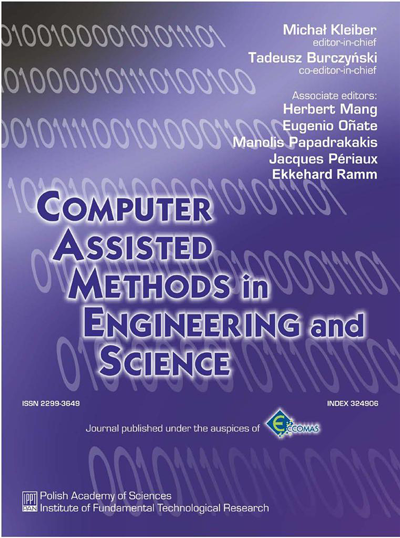Gaussian mixture model for time series-based structural damage detection
Abstract
In this paper, a time series-based damage detection algorithm is proposed using Gaussian mixture model (GMM) and expectation maximization (EM) framework. The vibration time series from the structure are modelled as the autoregressive (AR) processes. The first AR coefficients are used as a feature vector for novelty detection. To test the efficacy of the damage detection algorithm, it has been tested on the pseudo-experimental data obtained from the FEM model of the ASCE benchmark frame structure. Results suggest that the presented approach is able to detect mainly major and moderate damage patterns.
Keywords
dynamics, inverse problems, structural monitoring, damage detection, mixture model, novelty detection,References
[1] C.M. Bishop. Pattern Recognition and Machine Learning. Springer, New York, 2006.[2] C.J. Black, C.E. Ventura. Blind test on damage detection of a steel frame structure. In 16 th International Modal Analysis Conference; Santa Barbara, CA, pages 623–629. Society for Experimental Mechanics, Inc, 7 School St, Bethel, CT 06801, USA, 1998.
[3] A.P. Dempster, N.M. Laird, D.B. Rubin. Maximum likelihood from incomplete data via the EM algorithm. Journal of the Royal Statistical Society. Series B (Methodological), 39(1): 1–38, 1977.
[4] S.W. Doebling, C.R. Farrar, M.B. Prime. A summary review of vibration-based damage identification methods. Shock and Vibration Digest, 30(2): 91–105, 1998.
[5] C.R. Farrar, S.W. Doebling, D.A. Nix. Vibration–based structural damage identification. Philosophical Transactions of the Royal Society of London. Series A: Mathematical, Physical and Engineering Sciences, 359(1778): 131, 2001.
[6] S.D. Fassois, J.S. Sakellariou. Time-series methods for fault detection and identification in vibrating structures. Philosophical Transactions of the Royal Society A: Mathematical, Physical and Engineering Sciences, 365(1851): 411, 2007.
[7] M.R. Hernandez-Garcia, M. Sanchez-Silva. Learning machines for structural damage detection. Idea Group Publishing, 2007.
[8] E.A. Johnson, H.F. Lam, L.S. Katafygiotis, J.L. Beck. A benchmark problem for structural health monitoring and damage detection. In Proc. of 14th Engineering Mechanics Conference, Austin, TX, 2000.
[9] E.A. Johnson, H.F. Lam, L.S. Katafygiotis, J.L. Beck. Phase I IASC-ASCE Structural Health Monitoring Benchmark Problem using Simulated Data. Journal of Engineering Mechanics, 130(1): 3–15, 2004.
[10] K. Worden, W.J. Staszewski, J.J. Hensman. Natural computing for mechanical systems research: A tutorial overview. Mechanical Systems and Signal Processing, 25(1): 4–111, 2011.
[11] R.A. Martin. Unsupervised anomaly detection and diagnosis for liquid rocket engine propulsion. In Proceedings of the IEEE Aerospace Conference, Big Sky, pages 1–15, 2007.
[12] I.T. Nabney. Netlab: Algorithms for Pattern Recognition. Springer-Verlag, London, 2002.
[13] K.K. Nair, A.S. Kiremidjian. Time Series Based Structural Damage Detection Algorithm Using Gaussian Mixtures Modeling. Journal of Dynamic Systems, Measurement, and Control, 129: 285–293, 2007.
[14] K.K. Nair, A.S. Kiremidjian, K.H. Law. Time series-based damage detection and localization algorithm with application to the ASCE benchmark structure. Journal of Sound and Vibration, 291: 349–368, 2006.
[15] P. Nazarko, L. Ziemiański. Towards application of soft computing in structural health monitoring. In Proc. of the 10th Int. Conf. on Artifical Intelligence and Soft Computing: Part II, pages 56–63. Springer-Verlag, 2010.
[16] M. Rucka, K. Wilde. Neuro-wavelet damage detection technique in beam, plate and shell structures with experimental validation. Journal of Theoretical and Applied Mechanics, 48(3): 579–604, 2010.
[17] M. Słoński. Structure damage localization based on the relevance vector machine. In Proc. of 4th European Conference on Computational Mechanics (ECCM-2010), Paris, France, 2010.
[18] M.M.R. Taha. A Neural-Wavelet Technique for Damage Identification in the ASCE Benchmark Structure Using Phase II Experimental Data. Advances in Civil Engineering, 2010.
[19] L. Tarassenko, D.A. Clifton, P.R. Bannister, S. King, D. King. Novelty detection. In Boller Ch., Chang F.-K., Fujino Y., editors, Encyclopaedia of Structural Health Monitoring. John Wiley and Sons, 2009.
[20] C.E. Ventura, J.F. Lord, M. Turek, A.M. Sereci, D. Radulescu, C. Radulescu. Experimental studies and remote monitoring of iasc-asce benchmark test frame. In Proc. of the XXI Intl. Modal Analysis Conf, pages 3–6, 2003.
[21] Z. Waszczyszyn, L. Ziemiański. Neural networks in mechanics of structures and materials-new results and prospects of applications. Computers & Structures, 79(22–25): 2261–2276, 2001.
[22] K. Worden, G. Manson. The application of machine learning to structural health monitoring. Philosophical Transactions of the Royal Society A: Mathematical, Physical and Engineering Sciences, 365(1851): 515, 2007.
[23] X. Wu, J. Ghaboussi, J.H. Garrett. Use of neural networks in detection of structural damage. Computers & Structures, 42(4): 649–659, 1992.
Published
Jan 25, 2017
How to Cite
SŁOŃSKI, Marek.
Gaussian mixture model for time series-based structural damage detection.
Computer Assisted Methods in Engineering and Science, [S.l.], v. 19, n. 4, p. 331-338, jan. 2017.
ISSN 2956-5839.
Available at: <https://cames.ippt.gov.pl/index.php/cames/article/view/83>. Date accessed: 31 may 2025.
doi: http://dx.doi.org/10.24423/cames.83.
Issue
Section
Articles




